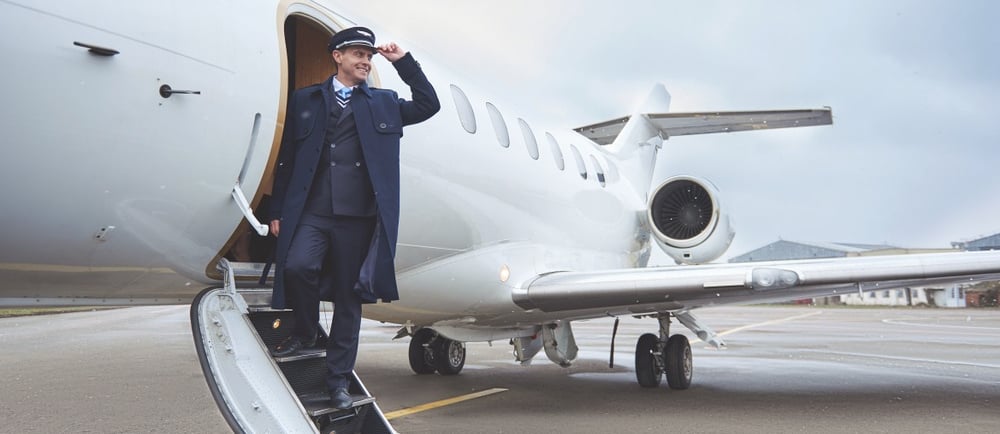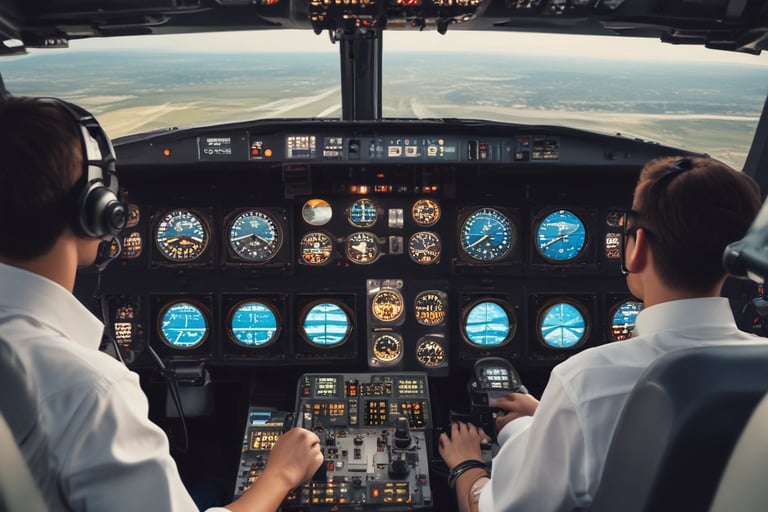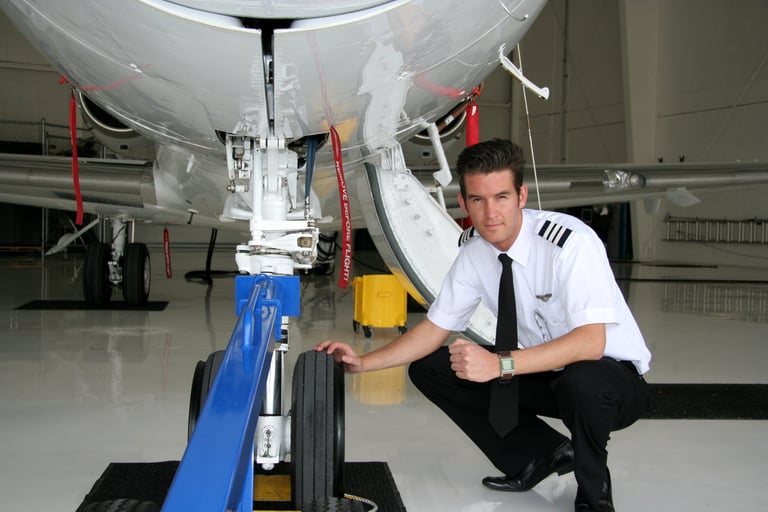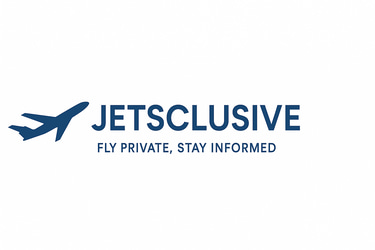Private Jet Pilots: How Experienced Are They Really
Think flying private means less training? Think again. Learn about the qualifications, experience, and rigorous standards private jet pilots must meet.
HOME
Jetsclusive
6/12/202514 min read


Private Jet Pilots: The Real Experience and Qualifications Explained
When people think of private jet pilots, images of skill and calm confidence usually come to mind. There's an appeal to the job, a sense that these aviators possess something special behind the controls. But how much expertise do private jet pilots really have, and what does it take to earn that trust?
Private jet pilots bring a wealth of real-world flying experience and deep training to the cockpit. Many have thousands of flight hours, several advanced ratings, and ongoing assessments that go beyond basic requirements. Understanding the true scope of their qualifications not only demystifies the job but helps travelers know exactly who's flying their aircraft. This article cuts through the myths and offers a closer look at the facts behind private jet pilot experience and training.
Typical Background and Experience of Private Jet Pilots
If you imagine private jet pilots as seasoned professionals with impressive flying credentials, you're not far off. These pilots draw from years of rigorous training, broad experience, and continued instruction. Each path to the private jet cockpit shares common check-points, yet every pilot takes a unique route shaped by their background and goals. Let's break down what it typically takes to command a private jet, who these pilots are, and where their experience comes from.
Required Flight Hours and Career Milestones
Reaching the command seat of a private jet requires a long-term commitment. Here’s a look at the usual journey:
Basic Licenses: Every private jet pilot starts by earning a Private Pilot License (PPL). This demands a minimum of 40 flight hours; most pilots log far beyond that before moving forward.
Commercial Pilot Milestone: The next big step is the Commercial Pilot License (CPL), requiring at least 250 total flight hours. CPL holders are eligible to fly for compensation.
Instrument and Multi-Engine Ratings: Most private jet work demands at least an Instrument Rating, enabling safe flight in varied weather, and a Multi-Engine Rating, since nearly all jets have more than one engine.
Type Ratings and ATP: Larger jets require a type rating for that specific model. Many pilots hold an Airline Transport Pilot (ATP) certificate—the highest FAA license—which calls for 1,500 total flight hours, including cross-country and night time.
Typical Experience to Command: Most first officers (co-pilots) on jets have at least 1,000-2,000 flight hours. Captains typically have 3,000 or more. Reaching a command seat often means 8–12 years of progressive flying roles.
Advancement isn’t just about flying hours. Operators look at experience types: time in jets versus prop planes, recency of experience, and time spent as captain versus co-pilot. Many companies require recurrent training and regular simulator checks, which means learning and skill-building never stops.
Diverse Operational Backgrounds: Military, Commercial, and Civilian Routes
Private jet pilots come from a variety of aviation paths, each bringing a different flavor of experience to the cockpit.
Military-Trained Pilots: Many private jet pilots are former military aviators. They often arrive with thousands of hours, top-notch simulator time, and advanced leadership skills. Military pilots excel at flying precise missions and handling complex procedures—skills highly valued in corporate aviation.
Commercial Airline Pilots: Some come from major airlines, either as active or retired pilots seeking a change. These pilots bring deep experience with larger aircraft, airline safety systems, and a culture of routine checks and procedures. Transitioning to business jets, they adapt quickly to new operating environments.
Direct-to-Corporate and Civilian-Trained Pilots: Another group comes up through civilian flight schools, logging hours as instructors, cargo pilots, or in charter operations. These pilots often have varied flying backgrounds, from small single engines to more advanced jets, giving them hands-on skills and flexibility.
Some pilots blend these backgrounds. For example, a civilian-trained instructor might later join the military reserves, or an airline pilot may fly charters on days off. Corporate and private aviation values adaptability, varied aircraft experience, and customer service skills, all of which are built from these diverse careers.
There is no single path to flying private jets—every pilot’s logbook tells a different story. What unites them is a foundation of strong training, a high bar for experience, and an ongoing push for excellence that keeps passengers safe at any altitude.
Training, Certifications, and Specializations for Private Jet Pilots
Pilots at the controls of private jets aren’t just skilled—they’re held to some of the highest training and certification standards anywhere in aviation. Each step along the way ensures these professionals have the precision, discipline, and judgment to handle advanced jets in all kinds of conditions. Here’s how the industry builds those layers of safety and expertise.
Essential Licenses and Endorsements
Private jet pilots reach their cockpit through a demanding series of required licenses and ratings. While every path is a little different, commercial jet operators demand a solid foundation of credentials before a pilot can operate high-end aircraft.
Private Pilot License (PPL): The starting point. This license requires a minimum of 40 flight hours split between training and solo time, plus written and practical tests. PPL holders can fly for pleasure, but not for pay.
Commercial Pilot License (CPL): The next step. A CPL shows that a pilot is qualified to operate aircraft for compensation. It typically requires 250 or more hours of total flight time, night flying, longer trips, and experience in complex airplanes.
Instrument Rating (IR): This rating lets pilots fly in clouds, rain, or low visibility conditions, using instruments instead of visual cues—vital for jet work.
Multi-Engine Rating: Most private jets have more than one engine. This endorsement confirms a pilot can safely handle multi-engine aircraft and their unique demands.
Airline Transport Pilot License (ATP): This is the top-tier license, required for captains of larger jets and usually expected by high-end operators. The ATP requires at least 1,500 total flight hours, along with extensive cross-country, night, and instrument experience.
Optional Endorsements: Some pilots pursue extras, like high-altitude operations, tailwheel, or advanced navigation training. These aren’t always required for private jets but do round out a versatile skill set.
Getting these licenses is just the start. Each endorsement means more rigorous training, close supervision, and tough check rides, all managed by the FAA or relevant national authority.
Type Ratings and Aircraft-Specific Training
Not every pilot can hop in any jet they like. Each major private jet comes with its own manual, quirks, and systems—and pilots need special permission, called a type rating, to fly many of them.
To get a type rating, pilots:
Complete Ground School: They learn about every system, button, and emergency in that specific aircraft, from avionics to hydraulic systems.
Log Simulator Sessions: Simulators are as close to the real jet as possible, where pilots face challenging emergencies and learn advanced handling, all without leaving the ground.
Fly with an Instructor: Initial flights in the real jet happen with an experienced instructor, followed by a check ride to prove their skill.
Pass Proficiency Checks: The final assessment is a tough test of both normal flight and emergency procedures.
Most jets above 12,500 pounds or with jet propulsion require a type rating. These are aircraft-specific, so a pilot with a rating for a Gulfstream G550 cannot just fly a Bombardier Global Express without more training and another check ride. Some families of jets with similar systems may share one rating, but any major difference means going through the process again.
What does this mean in the cockpit? Private jet pilots know every quirk, checklist, and alarm of their aircraft cold. Operators expect absolute proficiency with their assigned jet—not just in smooth skies, but in storms, busy airspace, or unexpected situations.
Recurrent Training, Safety Audits, and Ongoing Compliance
Private jet pilots’ training isn’t a one-and-done deal. To keep their seats, they go through constant learning and testing, usually every six to twelve months.
Key elements include:
Recurrent Training: This is a scheduled series of classroom refreshers, practical training, and simulator sessions. Instructors update pilots on new systems, changes in regulations, and advanced flying scenarios.
Simulator Sessions: Pilots regularly spend hours in high-tech simulators that recreate real-world emergencies or unusual situations. It’s a chance to practice engine failures, system malfunctions, and unusual weather in a safe environment.
Medical Examinations: Pilots must pass strict annual or semi-annual medical checks to keep their licenses and ratings active.
Proficiency Checks: Mandatory “check rides” or skill tests in both simulators and actual aircraft keep pilots sharp, proving they still meet all standards.
Safety Audits: Operators and oversight agencies (like the FAA) run regular checks on training records, safety performance, and compliance with rules. Gaps are addressed with more training or stricter oversight.
Recurrent instruction, frequent safety checks, and strict compliance create a strong safety net. The process never stops changing—jets upgrade their avionics, regulations evolve, and new risks are identified. Private jet pilots stay ahead of these changes, keeping skills razor sharp and passengers safe. The bar stays high, and pilots must keep rising to meet it.
Compare Private Jet Pricing Here
The Realities and Responsibilities of Private Jet Pilots
Every private jet pilot faces much more than just moving a plane from one runway to another. Their job blends technical flight skills, adaptability, and a sharp sense for luxury service. These aviators wear many hats, tackling a mix of high-stakes flying, detailed planning, and providing a personal experience to clients who expect the best. Here’s what really happens in the life of a private jet pilot.
Flight Operations: Pre-Flight, In-Flight, and Post-Flight Duties
The day starts before sunrise for many private jet pilots. Preparation is the backbone of safety and smooth service. Before even greeting passengers, pilots walk through a detailed checklist:
Pre-Flight Duties:
Scrutinize weather data, NOTAMs (alerts), and the latest flight plans.
Inspect every inch of the aircraft inside and out, checking fuel, avionics, hydraulics, and passenger amenities.
Coordinate catering, ground transfers, and ensure special passenger requests are handled.
Adjust plans last minute due to weather, airspace updates, or client changes.
In-Flight Responsibilities:
Manage takeoff procedures and monitor cockpit systems from start to finish.
Communicate continuously with air traffic control and adapt to turbulence or unexpected flight conditions.
Deliver a stress-free ride, update passengers with flight info, and check their comfort regularly.
Post-Flight Checks:
Perform a walk-around aircraft inspection, looking for wear or issues.
Complete flight logs and regulatory paperwork.
Debrief with the crew, review any in-flight challenges, and prep for the next assignment.
These steps are strict for one reason: private flying leaves very little room for error. Whether it’s a quick city hop or a long international charter, pilots must stay ready for anything—flexing all the skills that only experience can teach.
Adapting to Varied Aircraft and Operational Environments
Unlike airline work, flying private jets puts a premium on versatility. Crews may switch between aircraft with different cockpits, from sleek light jets up to long-haul luxury liners. Each model comes with unique quirks and system layouts. There’s no guarantee of flying the same plane two days in a row.
Pilots also adjust to a rotating cast of airports, from small executive airfields to busy international hubs. Some days it’s a fast turnaround at a remote spot; other days, it’s dealing with short runways, limited support, or fast-changing requirements.
Here’s how pilots stay agile:
Maintain several type ratings to fly various jet models.
Stay sharp on new technology, updated avionics, and advanced cockpit interfaces.
Master unfamiliar routes fast, using the latest navigation apps and airport guides.
Flex with short-notice schedule changes, weather surprises, or client requests to reroute mid-flight.
The private jet world demands pilots who think on their feet, make sound decisions fast, and never lose sight of passenger comfort or safety.
Customer Service and Interaction with High-Profile Clients
Flying a jet is only half the job. The other half is people. Most clients are busy executives, celebrities, athletes, or families looking for privacy and top-tier comfort. Onboard, pilots are expected to set the tone for a personalized, stress-free experience.
Key expectations include:
Professionalism and Discretion:
Every word and action matters, especially around well-known guests. Pilots often sign NDAs and keep all travel details confidential.Anticipation of Needs:
From arranging the right snacks to considering special requests like pets or extra security, pilots and crews tailor the service to fit each passenger.Clear Communication:
Explaining schedule changes or flight details with patience and positivity goes a long way. Clients expect clarity, not jargon or confusion.Problem-Solving:
When plans shift without notice, pilots step up—finding alternative airports, adjusting catering, or even suggesting new flight plans on the fly.
Delivering on these client-facing skills is what separates good private jet pilots from great ones. Their reputation isn’t just about flying safely. It’s about building trust, reading every situation, and making each trip feel effortless for the people onboard.
In private aviation, pilots become the face of service as much as they’re the guardians of the flight. This blend of technical expertise and customer focus defines the real job—and creates an unmatched flying experience for every client.
Common Myths and Misconceptions About Private Jet Pilots
When it comes to private jet pilots, there’s no shortage of rumors and misconceptions floating around. Some people picture laid-back flyers with fewer hours, while others worry about safety simply because the aircraft are smaller. Let’s cut through the noise and dig into the actual facts behind the most common myths, starting with the question that always comes up: how do private jet pilots really stack up against those flying for the airlines?
Comparing Private Jet and Airline Pilots: Who’s More Qualified?
A lot of folks assume that airline pilots outclass their private jet counterparts when it comes to qualifications and skill, but that just isn’t the case. Both groups operate under serious regulations and high standards, yet the paths to their cockpits can look a bit different.
What both sets of pilots have in common:
Rigorous FAA standards: Both must meet strict Federal Aviation Administration (FAA) requirements, including commercial licenses and regular medical checks.
Type ratings and advanced training: Pilots flying jets—commercial or private—need special type ratings for each model, plus ongoing check rides in simulators or actual aircraft.
Recurrent training: Every six to twelve months, both private and airline pilots re-qualify through simulator scenario tests, emergency drills, and refresher classes.
Where differences crop up:
Flight hours: Major airlines often require thousands of hours (typically well over 1,500) before hiring, but so do many top private operators. In fact, many private jet pilots are airline or military veterans with extensive backgrounds.
Operational complexity: Private jet pilots frequently fly to smaller, less predictable airports, often in unfamiliar locations, and deal with a wider variety of weather, terrain, and client preferences. This takes flexibility and sharp problem-solving that goes far beyond just managing a checklist.
Hands-on roles: Unlike airline crews, private pilots often handle everything from flight planning to passenger care. This means they not only fly the plane but also play a direct role in ensuring safety and client comfort.
Reality Check:
Most private jet pilots are just as qualified as their airline peers, and sometimes even more so, thanks to wide-ranging experience and higher expectations for adaptability. The key thing? Pilots in private aviation face a high bar for training, certification, and ongoing testing. You’re not getting less skill or experience—just a broader style of flying.
Safety Standards in Private Aviation
Worries about private jet safety often come down to myths about aircraft size and false ideas about lax oversight. The data clearly tells a different story.
Let’s set the record straight:
Strict regulatory oversight: In the U.S., private jets must meet rigorous FAA rules—from annual in-depth inspections to strict maintenance schedules and crew certifications. Most operators go a step further, picking up extra safety accreditations from groups like ARGUS or IS-BAO, which involve regular audits and deep safety reviews.
Advanced tech and safety gear: Modern private jets use the same advanced technology you’d find in an airliner, including Traffic Collision Avoidance Systems (TCAS), Enhanced Ground Proximity Warning Systems (EGPWS), and the latest satellite-based navigation. Even light jets come packed with these tools, leveling the playing field with big commercial aircraft.
Impressive safety record: According to recent stats, private jets have an accident rate of about 1.05 per 100,000 flight hours—right in line with, and sometimes better than, commercial airlines. In the world of high-end charter and corporate flights, that number drops even lower: just 0.07 per 100,000 hours.
Experienced pilots only: Pilots must log extensive hours in all conditions, manage “proficiency checks” every year, and pass medical exams twice as often as the average commercial pilot. Add to this regular simulator drills for emergencies and weather scenarios.
Versatile operations: Private jets can access thousands of airports that commercial airlines never reach, shortening routes and sidestepping congested airspace. Smaller doesn’t mean less safe; it means more flexible and responsive.
Bottom Line Points:
Regulatory standards for private jets are every bit as tough as those for airlines.
The idea that smaller planes mean higher risks simply doesn’t match up with the facts.
Regular audits, advanced systems, and well-trained pilots keep private aviation standards sky high.
If you’re picturing private jet pilots as anything less than top professionals, it’s time to revise that mental image. They’re at the top of their game—just working in a slightly different, and often more complex, flying environment.
Compare Private Jet Pricing Here
Career Outlook and Industry Trends
The private jet pilot career is at an exciting crossroads in 2025. After years of growth, the sector remains in high demand, fueled by new aircraft deliveries, soaring interest from first-time buyers, and greater expectations for technology and sustainability. Today’s private jet pilots aren’t just flying aircraft; they’re shaping a space that prizes expertise, flexibility, and a premium experience.
Growing Industry Demand
Private aviation is booming. Global forecasts project the market will reach nearly $40 billion by the end of 2025, with North America leading the charge. This demand comes from several drivers:
More first-time flyers and buyers: The pandemic shifted travelers’ habits, introducing many who now prefer private options for safety and convenience.
Businesses and families alike turn to private jets for flexibility as airlines cut routes or raise fares.
Backlogs in new aircraft deliveries: Jet manufacturers like Gulfstream and Bombardier face waitlists as long as 18-30 months, keeping the flow of new jobs steady.
Continued pilot shortage: Retirement among airline and business aviation pilots is outpacing the number of new entrants. Experienced pilots are in demand, and low-time pilots see slower job growth.
Key takeaway: If you’re looking to build or advance a career as a private jet pilot, there’s never been a better time. The need for skilled, versatile aviators is soaring.
Salary Expectations
Pilot pay is on the rise—and private jet pilots are reaping the rewards. Salary depends on experience, aircraft type, and where you fly, but the numbers are strong:
Entry-level first officers: $50,000–$85,000 per year
Experienced captains with 5,000+ hours: $160,000–$300,000 per year
Top-tier pilots flying large-cabin jets (like Gulfstream G650): $250,000+ annually
Freelance/day-rate captains: $1,500–$3,000 per day, plus expenses for some roles
Flight attendants: $35,500–$100,000, depending on route and expertise
Private jet flying usually pays more than commercial aviation, thanks to signing bonuses, per diem, and high demand. Major metro areas and international hubs, like New York, Los Angeles, Dubai, and London, offer some of the industry’s highest compensation.
Key point: Strong pay meets real opportunity—especially if you’re willing to earn new type ratings or keep moving up to larger aircraft.
Advancement Opportunities
The private jet career path isn’t stuck on autopilot. There’s room to move up, specialize, and even branch out:
Upgrading to larger jets: As you gain hours and type ratings, you can move from light or midsize jets to long-range models that pay more.
Chief pilot or director of operations: Experienced captains often step into flight department leadership, overseeing training, safety, and hiring.
Flight training or examiner roles: Many pilots transition into sim instruction, FAA check airman work, or specialized training for new technology.
Emerging technology pilots: The arrival of electric and hybrid aircraft, advanced autopilot, and new safety systems is creating demand for pilots with tech skills.
Smart pilots keep learning and expanding their credentials. Holding several type ratings or specialized training makes you stand out, giving you access to more assignments and better pay.
Future Trends and Industry Outlook
Private aviation is adapting fast. Environmental concerns and customer expectations are shaping a high-tech, sustainable future:
More sustainable aviation fuels (SAF) and hybrid-electric jets are coming into service, prompting new training.
Cabin innovation: Luxury now means smart entertainment, health-focused systems, and ultra-quiet cabins.
Enhanced safety tech: Pilots need to know the latest avionics, terrain warning, and automated safety features.
AI and digital flight management: New booking systems, maintenance tracking, and real-time regulatory compliance tools change how pilots prepare and report.
The trend is clear: pilots with advanced training and tech/cabin know-how will be in demand. Market growth in Asia-Pacific, the Middle East, and Latin America will also open international roles for those willing to travel.
In summary: The private jet pilot job outlook is robust, with higher pay, bigger job variety, and a shift toward technology and sustainability. If you’re passionate, curious, and ready to learn, private aviation can build a rewarding, future-proof flying career.
Conclusion
Private jet pilots bring a level of skill and professionalism shaped by years of rigorous training, broad flight experience, and a strong commitment to ongoing learning. Their day-to-day work demands sharp judgment, versatility, and a steady hand when it matters most. These aviators handle more than just flying—they deliver tailored service, adapt to changing demands, and prioritize passenger safety at every turn.
What sets private jet pilots apart goes beyond flight hours or certifications. It’s their ability to blend customer focus with technical precision, all while navigating a fast-changing industry. Their unique mix of expertise, flexibility, and personal touch gives private aviation its trusted reputation.




Luxury
Explore the world of private aviation and travel.
support@jetsclusive.net
© 2025. All rights reserved.
